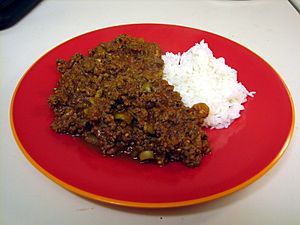Picadillo facts for kids

Picadillo is a yummy traditional dish. It's popular in many Latin American countries and the Philippines. The word "picadillo" comes from the Spanish word picar, which means "to mince" or "to chop".
This dish is usually made with ground meat, most often beef. It also includes tomatoes, and sometimes tomato sauce. Many recipes add raisins and olives, but the exact ingredients change from place to place. Picadillo is often served with rice. It can also be used as a tasty filling for dishes like tacos, pastries, or croquettes.
Contents
The History of Picadillo
Picadillo has been around for a long time! In the 1800s, people in California made a dish called pasteles a la argentina. This was a pastry filled with layers of beef picadillo and chicken. It also had a green chili and onion sauce with olive oil and raisins.
Interestingly, picadillo wasn't always made with beef. Sometimes, it was made with minced fowl (like chicken or other birds) and a creamy white sauce. There was even a savory pie called Pasteles de pollos y pichones. This pie had layers of chicken and squab (young pigeon). It also included a picadillo made with minced veal, bacon, ham, onions, mushrooms, apples, artichokes, and tomatoes.
Picadillo Around the World
Picadillo is made differently depending on where you are. Let's explore how this dish changes from country to country!
Picadillo in Costa Rica
In Costa Rica, picadillo is usually named after its main vegetable. For example, you might hear of "potato picadillo" or "ayote picadillo." The main vegetable is chopped and cooked with bell peppers, onions, broth, herbs, and spices. Sometimes, it includes meat, but not always. Costa Rican picadillo is often eaten with tortillas or rice.
Picadillo in Cuba
Cuban picadillo often includes bell peppers, onions, garlic, oregano, cumin, tomato sauce, and broth. It also has olives and raisins. Sometimes, potatoes and capers are added too. Cuban picadillo is usually cooked in olive oil and sometimes with white wine. It is often served with black turtle beans and rice.
Picadillo in the Dominican Republic
In the Dominican Republic, picadillo includes peppers, onions, cilantro, garlic, tomato paste, and bouillon cubes. It might also have olives, capers, raisins, or hard-boiled eggs. This version is served over rice. It's also a popular filling for dishes like pasteles, empanadas, kibbeh, and cabbage rolls.
Picadillo in Puerto Rico
In Puerto Rico, picadillo is a common filling for empanadas, alcapurria, piononos, and other fritters. It can also be served with rice and beans. The ground meat is cooked with annatto oil, ham, cumin, oregano, bay leaf, recaito, and tomato sauce. Sometimes, cheese, raisins, beans, olives, capers, or potatoes are added. The tomato sauce helps all the ingredients stick together.
Picadillo in the Philippines
In the Philippines, picadillo is often a soupy dish. It's traditionally made with ground beef and either potatoes or chayote. There are also drier versions of the dish. Filipinos also call it giniling, which means "ground meat" in Tagalog.
What Cubans call picadillo is known as arroz a la cubana (Cuban-style rice) in the Philippines. This Philippine version is similar to other Latino picadillos. It usually has raisins, tomato sauce, and diced potatoes. However, it often doesn't include green olives and capers. It's commonly served with white rice, fried plantains (called saging na saba), and a fried egg on top. Boiled eggs are also sometimes eaten with it.
Picadillo in Mexico
Mexico is a very large country, so its cuisine has many regional differences.
Northern Mexico Picadillo
In the northern part of Mexico, picadillo is made simply. It uses fresh tomatoes, onions, ground meat, beef broth, and potatoes. It's usually seasoned with salt, pepper, and cumin. Many people wrap it in a tortilla or eat it with corn chips and salsa.
Sweet and Savory Picadillo
In some other parts of Mexico, onions and lime are stirred into the meat while it cooks. The sauce is sometimes made a bit sweet by adding sugar or even honey. This gives the dish a taste similar to teriyaki or bulgogi. Raisins can also be added for more sweetness. In coastal areas, seafood like shellfish or tuna might be used instead of beef.
Spicy Picadillo
In other parts of Mexico, picadillo is made with blended guajillo chiles, sautéed onions, and tomatillos. This gives it a spicier flavor.
Images for kids
See also
 In Spanish: Picadillo para niños
In Spanish: Picadillo para niños


